10 Ecom success stories
Let’s jump right in.
1How Beardbrand Turned A Growing Community Into An eCommerce Store With $20,000 In Sales Every Day
2How Beer Cartel Used Content Marketing To Increase Revenue By $65,000
3How Traveller Collective Used User-Generated Content To Grow Their eCommerce Business
4How Bushwick Kitchen Used PR To Generate Over $170,000 In Its First 12 Months
5How Neon Poodle Expanded Across 3 Continents And Grew Revenue by 232%
- HOW BEARDBRAND TURNED A GROWING COMMUNITY INTO AN ECOMMERCE STORE WITH $20,000 IN SALES EVERY DAY

Eric Bandholz has an incredible beard. And his passion for facial hair has taken him, and his company, Beardbrand, on an unbelievable journey since the business was founded in 2012.
From humble beginnings as a YouTube channel and blog, Beardbrand has grown into a hugely successful eCommerce business making thousands of dollars in sales every single day.
As Eric created content about beard care, male grooming, and beard culture, he quickly realized the beard community had plenty of unmet grooming product needs.
So as all great entrepreneurs do, he set out to plug this gap in the market and Beardbrand was born. They launched their first grooming products in 2013; the catalyst was Bandholz’s blog being featured in the New York Times.

Bandholz explains:
“Beardbrand's community was moving along as normal, when I was contacted by a New York Times reporter. The reporter was doing a story on beard care products and wanted my expertise. She was also impressed with the small community that was starting to grow.”
Knowing they had this feature coming up, the Beardbrand team rallied to turn the blog into something more than a content hub and they managed to launch the Beardbrand online store one day before the article was published.
The New York Times feature helped Beardbrand to acquire a few initial customers, “but wasn't like a Niagara Falls worth of business,” Bandholz told Shopify.[*]
Since then, much of Beardbrand’s success has come down to their laser focus on community, their vision, and messaging.
Their mission—“To Foster Confidence Through Grooming”—is featured front and center of their homepage:

And throughout their eCommerce site, you get the feeling that Beardbrand sincerely wants “beardsmen”—a term coined by Bandholz referring to men with facial hair—to feel proud of their beards and take real pride in their appearance.
From the “What Type of Beardsman Are You?” quiz:

To their blog covering topics like style, grooming, and travel:
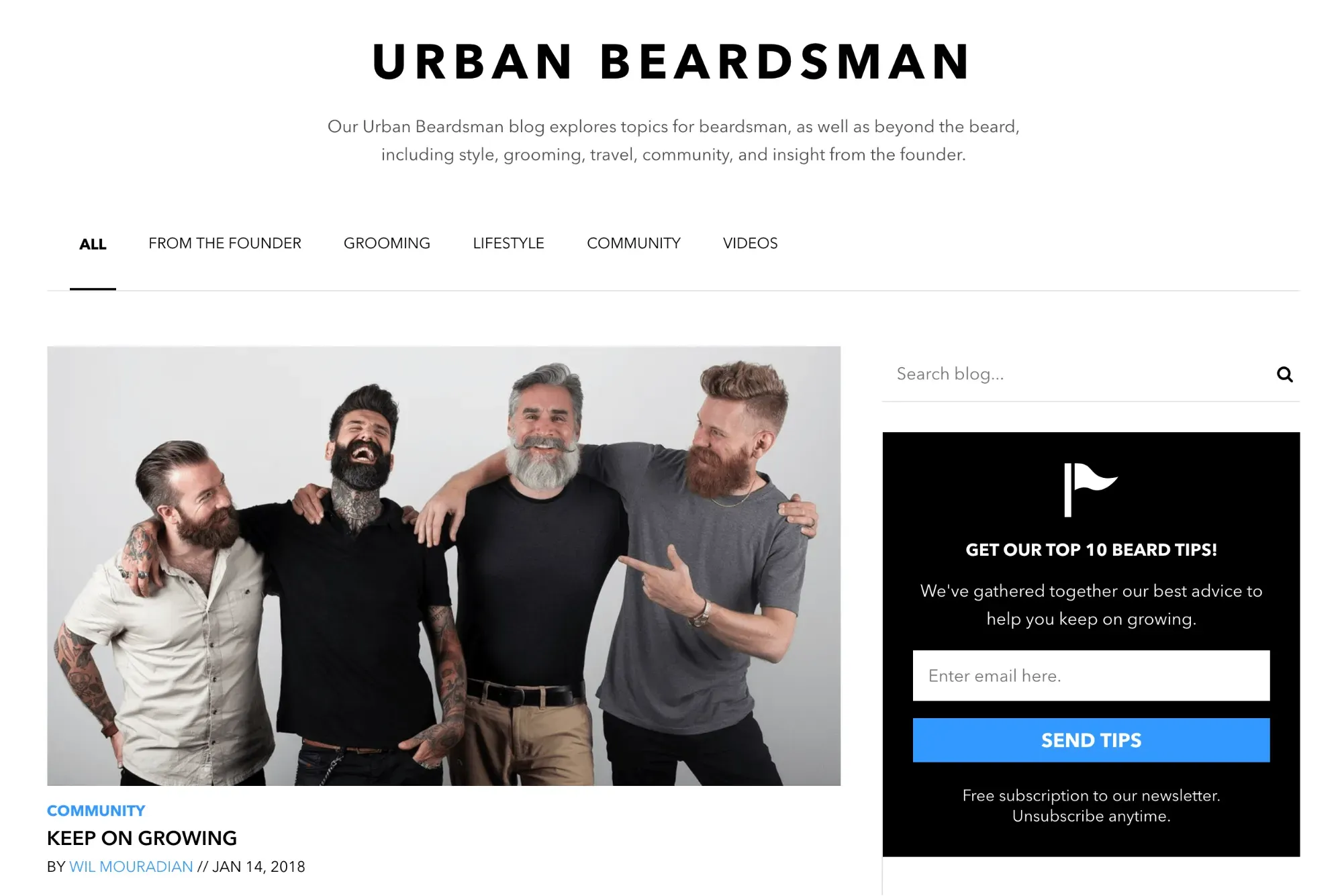
Much of the Beardbrand website is dedicated to resources aimed to help “beardsmen” understand more about their beards and learn how to be the best version of themselves—aligning with Beardbrand’s vision “To Foster Confidence Through Grooming”.
THE TAKEAWAY: FOCUS ON THE MISSION OF YOUR BUSINESS AND “WHY” YOU EXIST
Beardbrand is an eCommerce business. But it doesn’t purely exist to sell grooming products to customers.
Beardbrand’s reason for existence goes much deeper than that. First and foremost, the company wants to help men feel more confident in themselves and it just so happens that grooming products is one of the ways they do that.
Whether you’re just starting out your eCommerce store or running a well-established eCommerce business, think carefully about “why” your business exists. Understanding this “why” and having a real mission behind your business will help you to connect with your customers and build true relationships.
Just look at Nike, one of the most successful commerce companies in history; their mission is "To bring inspiration and innovation to every athlete in the world." And if you’ve ever seen one of their adverts or interacted with the brand in any way you can see how that mission guides everything they do.
Want to learn more about Beardbrand’s journey? Check our Chief Sumo’s interview with Beardbrand founder Eric Bandholz below:
- HOW BEER CARTEL USED CONTENT MARKETING TO INCREASE REVENUE BY $65,000

Beer Cartel is an eCommerce company founded in 2009, and they stock the largest range of craft beers in Australia, with over 1,100 beers on offer.
In 2017, Beer Cartel founder Richard Kelsey wanted to grow his business and gave the company four specific challenges:
- To create publicity for Beer Cartel
- To be seen as a thought leader in the craft beer space
- To increase Beer Cartel’s mailing list
- To drive an increase in sales
To tackle these challenges Beer Cartel turned to content marketing.
Instead of copying and pasting the same types of content as every other business out there, Beer Cartel created something unique: the Australian Craft Beer Survey.

The survey asked questions that helped Beer Cartel to understand the craft beer market. It opened up with some qualifying questions to help Beer Cartel understand their respondents, asking for:
- Respondents age range
- Gender
- What types of alcoholic drinks they have consumed in the past 4 weeks
The survey then moves into a group of more craft beer focused questions like:
“Which of the following is your preferred beer type?”

“How long ago did you first start drinking craft beer?”

“How experienced are you with craft beer?”

Next, once the survey was created, Beer Cartel had to get people to participate in the survey, which can be notoriously difficult.
To navigate this challenge, Beer Cartel took a unique, two-pronged approach.
First, Beer Cartel knew that it would need help from other brands in the industry to spread the word about the survey.
But instead of sending a generic “we’re running a survey, would you help us promote it?” message, it crafted a compelling offer for other brands in the Australian craft beer industry.
To encourage sharing and support of the survey, any business that promoted the survey would receive a free copy of the industry report generated from the survey results. So by simply sharing a survey, each participating business could gain some important insights into the Australian craft beer industry and its customers.

It was a win-win situation.
Beer Cartel would receive publicity for its survey, and any business sharing the survey would in turn receive information that will help them to better understand their market and customers.
In the blog post launching the survey that you see above, Beer Cartel also offered other businesses direct contact with founder Richard Kelsey to help them get set up with a unique promo link.[*]
This approach was hugely successful; just look at number of businesses that supported the survey:

And second, to encourage consumers to take the survey, Beer Cartel created a couple of offers. For anyone who completed it, they would:
- Have the chance to win $500 of craft beer
- Receive a coupon code to get $10 off their next order from Beer Cartel
In total, more than 17,000 people took the survey.
The survey results were published on Beer Cartel’s blog and helped grow their site traffic by 100%— from 62,000 unique website visits in 2016 to 128,000 in 2017.[*]
But it wasn’t just the traffic that increased from this campaign:[*]
- Revenue in 2017 increased by $65,000 (34% increase over 2016)
- Beer Cartel’s mailing list increased by 130% from 13,000 in 2016 to over 30,000 subscribers in 2017
- More than 20 articles were written about the survey, increasing awareness and backlinks to Beer Cartel’s site
THE TAKEAWAY: CREATE UNIQUE CONTENT THAT DELIVERS NEW INSIGHTS
Content marketing is very hard to get right. But as Beer Cartel proves, if you do manage to get it right, content marketing can deliver incredible results for your eCommerce business. Who wouldn’t like a 34% increase in revenue?
If you want content marketing to work for you, though, you need to take a fresh approach and deliver content that truly creates value for your industry and customers.
- HOW TRAVELLER COLLECTIVE USES USER-GENERATED CONTENT TO GROW THEIR ECOMMERCE BUSINESS

Darryl McIvor is passionate about travel and his mission upon starting Traveller Collective was to create something for people who love to travel and want to do something about the countless inequalities across the globe.
What McIvor created was a set of engraved rings for every country in the world. Travellers can collect these rings on a clip or necklace, and every purchase helps to fund a charitable project.

Over 10,000 travelers from more than 100 countries have bought rings from the Traveller Collective, and a huge part of this success is down to user-generated content.

The brand’s hashtag, #ontheroadwithtc, has been used more than 4,500 times on Instagram, and the brand regularly reposts user-generated content on their Instagram profile.[*]
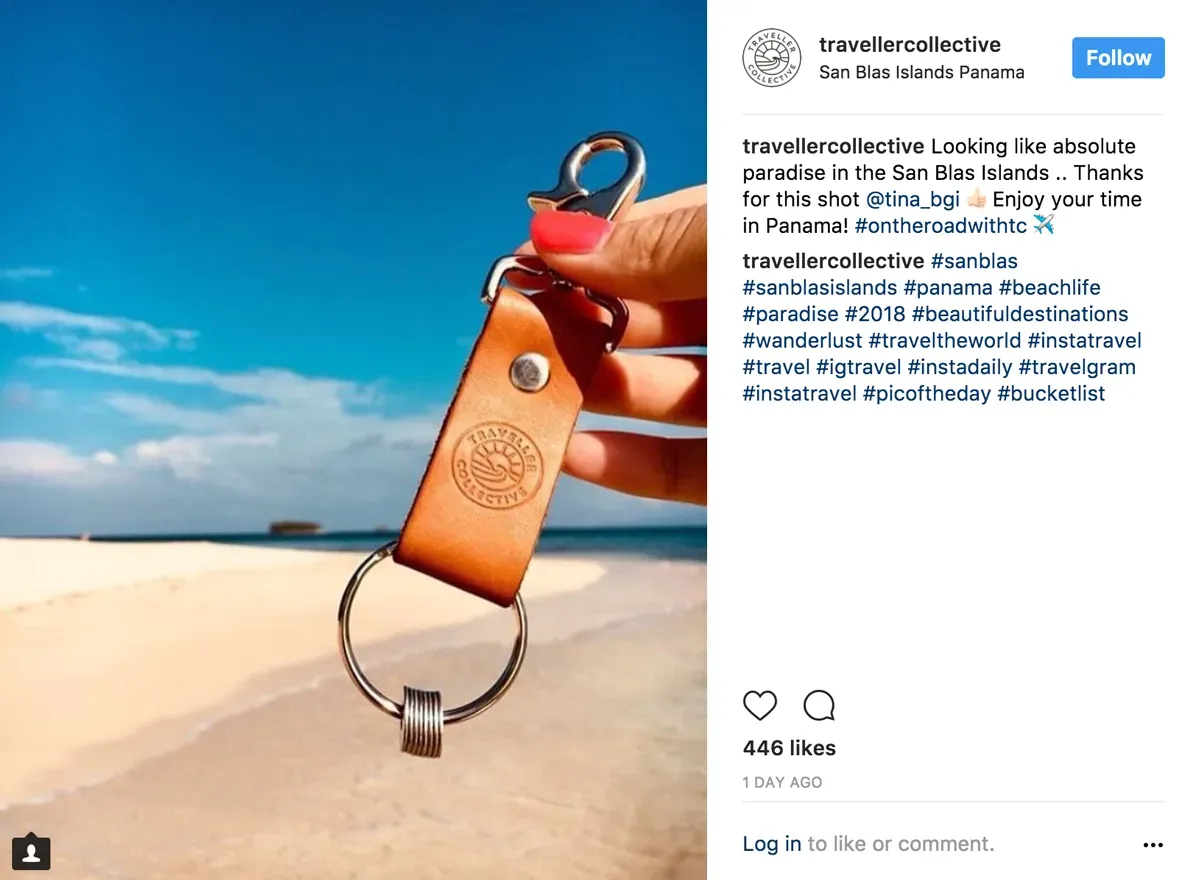
The Traveller Collective brand is built around sharing a passion for travel and being able to make a positive impact on the world. These two elements combine to create a unique, sharable experience for customers—enabling them to share their travel experiences with the world and also feel good that they’ve given back.
TAKEAWAY: CREATE A REMARKABLE EXPERIENCE AROUND YOUR PRODUCT
What Traveller Collective proves is that you don’t need a huge marketing budget to create buzz about your new eCommerce business. Instead, you just need a unique, shareable experience to get people talking about your brand.
This reminds me of a recent Sumo case study on how Sumo was able to generate more than $100k in a single day by giving website visitors a unique experience using Cart Casino.
Cart Casino is a game people on your website can play to win a discount. Here’s what it looks like:

Sumo set Cart Casino to show after one second for 24 hours on Sumo.com to make sure EVERYONE coming to the website would see it.
Because this wasn’t just another generic popup, it got interest from visitors and generated:
- 10x conversion rate compared to a normal popup
- 9,055 email leads in 24 hours
- Sumo’s biggest sales day EVER
Create unique, remarkable experiences for your customers on your website using Cart Casino on the eCommerce or Team plan — or find a way to make your product itself unique and shareable like Traveller Collective.
- HOW BUSHWICK KITCHEN USED PR TO GENERATE OVER $170,000 IN THEIR FIRST 12 MONTHS

What started out as a 30-day challenge between two friends: Morgen, an entrepreneur who founded Ideapaint and Casey, a food lover who wanted to create a hot sauce company, has blossomed into a highly successful eCommerce business.
The company started out as MixedMade in 2014 (it rebranded to Bushwick Kitchen in 2016) and in its first year, the company generated $170,000 in revenue from its one product at the time, Bees Knees Spicy Honey.[*]
How did Bushwick Kitchen grow from a 30-day experiment to $170,000 in sales in one year?
First, Morgen and Casey wanted to validate their idea before they invested in manufacturing and production costs.
To do this, they launched a simple website with:
- Designs of what they thought the product would look like
- A price, based on estimated costs
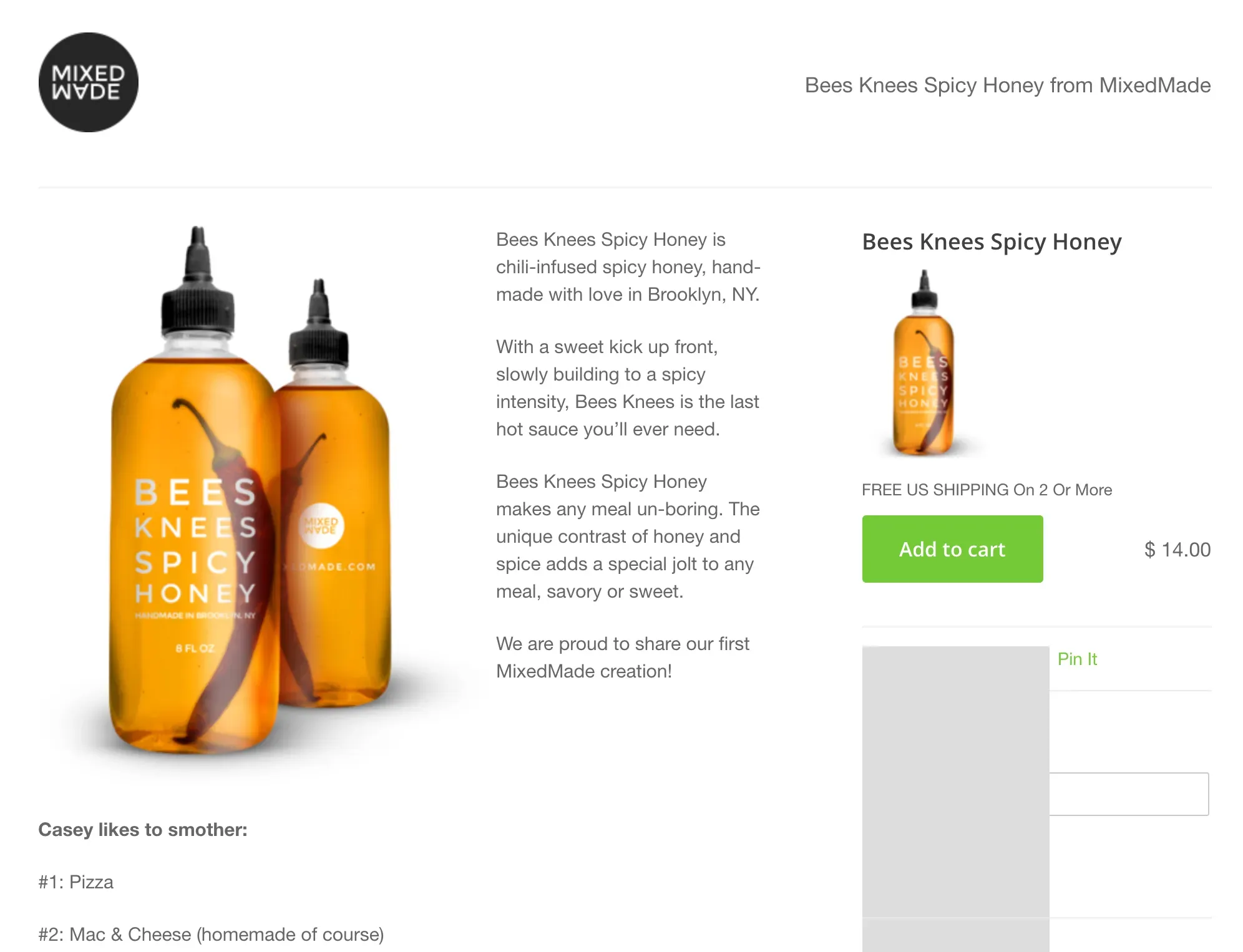
This simple sales page helped Morgen and Casey to pre-sell $525 of their spicy honey.[*]
With some initial sales in the bag, the duo began to produce the honey.
Then, to get a few extra sales and share his new adventure, Casey compiled a mailing list of 400 friends and contacts he’d picked up over the course of his career and sent out a message to them via email, which helped them get up to $1,000 in sales.[*]
Here’s a copy of the exact email Casey sent:[*]
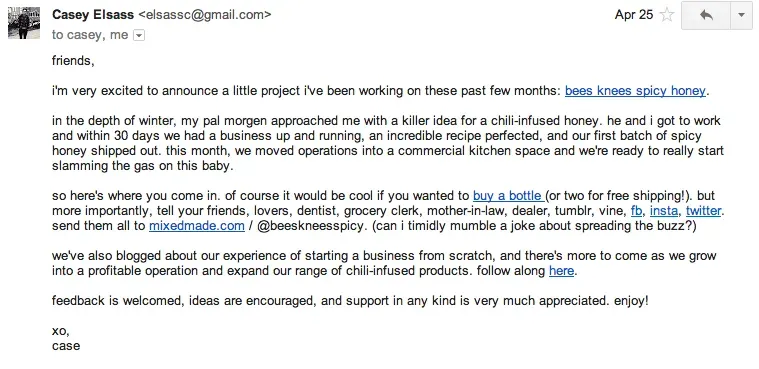
And once the first batches of the sauce had arrived, Morgen and Casey needed to really kick-start their growth. Their approach worked…
In August 2014, they sold 165 bottles of spicy honey. But in September that number grew over 500% to more than 840 bottles. The reason for this growth? Press coverage.[*]
Their spicy honey had been featured on many popular foodie sites, like:
Uncrate:

Grub Street:

Kitchn:

So how did they manage this?
A lot of it came down to old-fashioned hard work. Casey would spend hours following every lead, building his network and reaching out to food writers, editors, and bloggers.
And once he had uncovered a contact he’d follow his simple three-step press plan:[*]
- Build a relationship: Casey focused on building relationships with press contacts. Instead of going in and directly asking for coverage, he’d read and share their work, follow them on Twitter and try to create a genuine relationship.
- Help them do their job: Journalists have tough jobs. They need to create compelling, interesting stories every single day. Instead of sharing some details and hoping they’d turn it into a story, Casey would provide each journalist with a few ready-made story ideas about Bushwick Kitchen, including some images and copy for each option.
- Track and measure: Every form of marketing should be profitable. To ensure this, Casey used a CRM tool to track his relationships with influencers and writers as well as how much he’d spent on sending samples and the number of sales made by each piece of coverage. Casey used Zoho CRM to keep track of all press relationships and mentions and then it appears Shopify’s analytics provided them with information on top referral traffic and sales.
TAKEAWAY: TARGET RELEVANT AUDIENCES IN PLACES THEY HANG OUT ONLINE
Any press coverage is great to get the word out about your business. But relevant press coverage will also help you to move the needle on sales and revenue.
For example, when Morgen wrote a piece for Inc (it was also republished on Business Insider), it generated 560 clicks to their eCommerce store but just 2 sales:[*]

However, when Bushwick Kitchen received coverage on the more relevant food blogs like Uncrate, it generated 1,427 clicks and made 175 sales in just four days:

Whatever your industry, target highly relevant blogs, websites, and social media accounts for coverage.
- HOW NEON POODLE EXPANDED ACROSS 3 CONTINENTS AND GREW REVENUE BY 232%
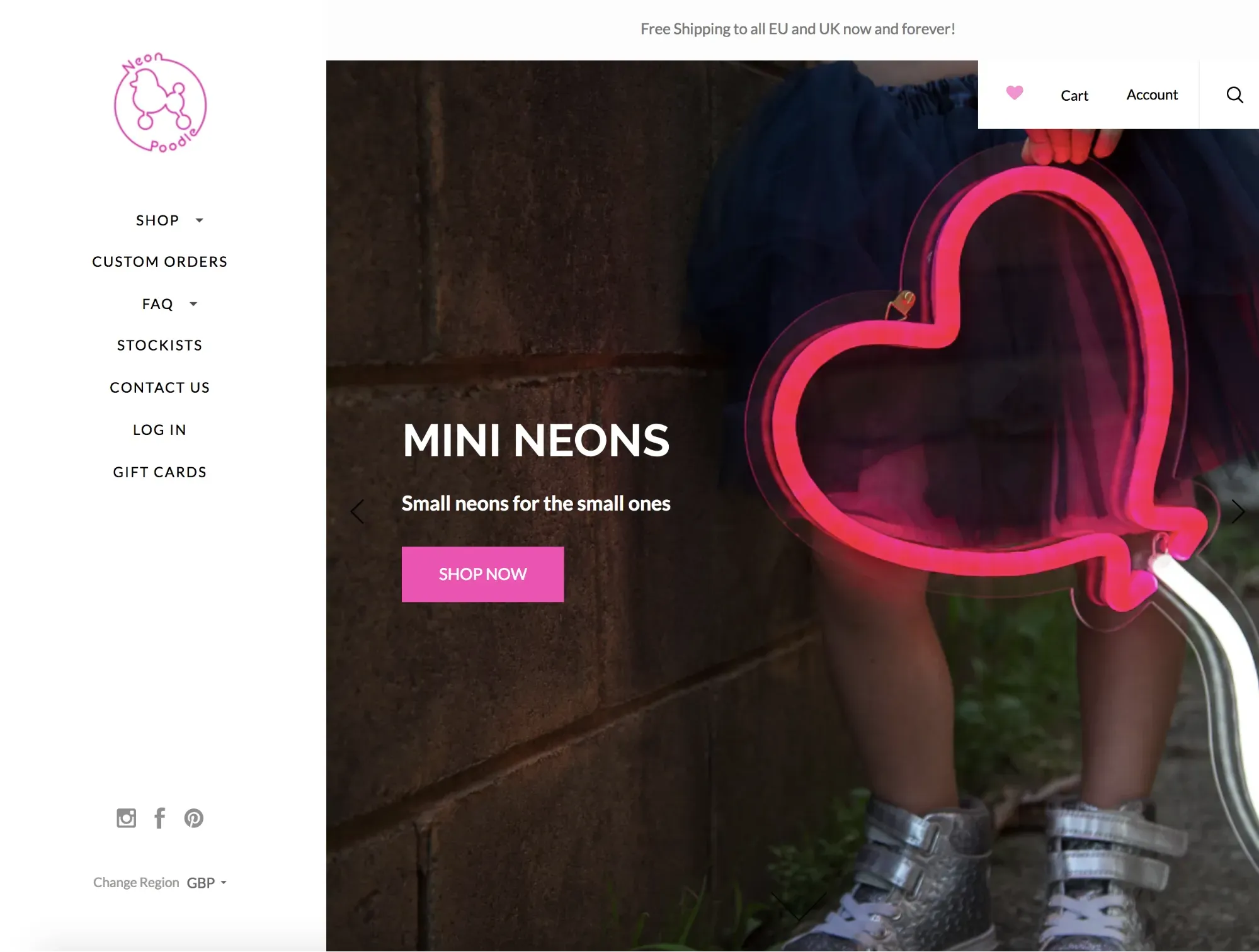
Neon Poodle was founded when Sammy Gibson wanted a customized, child-friendly neon sign for her daughter’s bedroom.
After failing to find something suitable, Sammy scratched her entrepreneurial itch and decided to create her own neon signs that were:
- Beautiful and simple to customize
- Safe to be used in children’s rooms
The result was Neon Poodle.
And in just three years, Neon Poodle became Australia’s #1 eCommerce store for neon signs.[*]
But with the Australian market reaching a saturation point, the biggest challenge for Sammy and her co-founder (and husband), Jason, became how to continue their growth.
They decided to go international, expanding their store into Europe and North America.
The expansion into these two additional markets took around 18 months with many hurdles to jump. For example:
- Finding couriers like ShipStation for U.S. orders and using Avalara for tax management across U.S. states
- Setting up Stripe to handle international payments without additional fees and costs
- Using BigCommerce to create dashboards for each country to manage and measure growth and sales in each location
But the results are astounding and prove that all Sammy and Jason’s hard work has definitely paid off as Neon Poodle’s revenue has grown by 232.14% since the international expansion.[*]
TAKEAWAY: CAST A WIDER NET TO BOOST GROWTH
When you first start out, it’s great to produce and sell products for a super-targeted niche group of customers.
This is exactly how Sammy started Neon Poodle… by selling custom neon signs to people in Australia.
But when you’re ready, one of the best ways achieve growth is to expand your market.
One of the best examples of this is Facebook. It started out as a network purely for college students, but when it had saturated that market, it opened up to all users.
Another example of expanding your market comes from our very own Chief Sumo. Back when Noah was running a Facebook games company called Gambit, he realized that half of their revenue was coming from international customers—yet zero of his marketing was focused on reaching people in these countries.
Hello, opportunity.
When you feel like your eCommerce store is starting to plateau, look at ways you might be able to expand your market. For example:
- Are you selling in just one country? Maybe you could expand into new places
- Do most of your sales come from one state/area? Test out some marketing campaigns targeting people in a different state
MAKE THIS YEAR YOUR BEST ONE YET
Using these five eCommerce success stories as inspiration, you can make this year your best year yet, whatever your goals:
- Keen to build a loyal community and customer base? Focus on your mission like Beardbrand did with their mission “To Foster Confidence Through Grooming” to help groomsman invest in themselves.
- Is content marketing under-performing for you? Create something unique and valuable for your customers like Beer Cartel did with their Australian Beer Craft Survey.
- Want to increase word-of-mouth buzz around your brand? Make your product truly remarkable and give people a reason to share it with their friends like Traveller Collective did with “The Clip” and their engraved country rings. Or create a remarkable experience on your website like Sumo did with Cart Casino to make $100k in a day.
- Need some more press mentions? Reach out to industry relevant influencers and journalists like Bushwick Kitchen did to get press for their Bees Knees Spicy Honey hot sauce on foodie sites like Uncrate, Grub Street and Kitchn
- Ready to grow your customer base? Try expanding your reach across states or go international like Neon Poodle did to expand from Australia into Europe and North America.
Want to see five more success stories from top ecommerce companies? Click the button below to get five more examples.
Running an ecommerce business is challenging. It’s easy to get swamped with all of the decisions that have to be made, mistakes along the way, and unforeseen disasters. However, it’s important to remember the bright side of running your own ecommerce business!
We wanted to share some ecommerce success stories because we all need a little encouragement from time to time. Even if you’re not yet decided on the type of ecommerce business that will work best for you, you want it to be a roaring ecommerce success. So here are five ecommerce success stories to inspire you and help lead you in the right direction for the coming year.
#1. Beardbrand
Austin-based Beardbrand had a rocky start as a Shark Tank reject. But founder Eric Bandholz had a strong epiphany – after he decided to grow a beard 10 years ago, he found it completely revolutionized how he lived life. He wanted the world to know that beards weren’t unkempt and lazy, but stylish and professional with the right grooming. Eric felt it was time to bust stereotypes about facial hair.
Although Beardbrand now has a turnover of $120k a month, it had to find its way. Over the years Beardbrand has experimented – it tried selling backpacks, wallets, sunglasses, and other things – so don’t fret if you’re still undecided about which type of ecommerce business you want to commit to!
Beardbrand soon discovered the company worked best when streamlined to well-made grooming products. But it also focused on giving value to their current customers, where it really excels with:
- Hilarious articles including an interactive voting for the greatest mustache of all time tournament

Beardbrand took a little history and turned it into a funny, interactive competition.
- Interactive quizzes about the type of beard and range of styles there are.
- A brilliant YouTube channel with 1.9 million subscribers featuring lots of makeovers, tips, growth logs, and videos with their larger-than-life barbers.

Beardbrand’s YouTube channel gives its customers information they need plus an insight into the brand and its barbers.
Beardbrand is a great lesson of being unafraid of who you are, knowing your audience has the same point of view, and making their world better because you’re in it. That’s the key to success.
#2. Dollar Shave Club
Dollar Shave Club is another disruptor in the grooming and shaving industry. It sells grooming products and razors tailored to each person’s skin needs and daily routine. The product line is reasonably priced. And for a dollar a month, customers get razors automatically ordered and delivered right to their door.
It’s successful because founder Michael Dubin knew what the market needed. It’s not that they need razors. It’s that they need one less thing to worry about. The brand is also successful because Michael Dubin is funny. After deciding to start the business he made a brilliant video called “Our Blades are F**king Great” which went viral.

Dollar Shave Club’s video cost $4,500 to make and brought in 12k razor subscribers overnight.
This approach gives valuable lessons:
- Don’t be afraid to stand-out – Differentiation is important, especially in a market that’s stuffed with big-named brands. Dollar Shave Club had confidence in its ability to stand out.
- Humor goes a long way – It’s a misconception that there’s only room for humor in the entertainment industry. Using a brash, clever type of humor will attract customers that are brash and clever.

Dollar Shave Club leans into what could have been an awkward message to the customer.
#3. Beer Cartel
Beer Cartel started in 2009 based on a hunch. Because it was hard for customers in Australia to get beer online, and craft beer was rare, it spotted a big opportunity to capitalize on the Australian love of beer. Then it committed to teaching customers about craft beer to deepen the customer relationship with the product, and made sure its social media showed up the amber nectar of the gods. And as a result, growth exploded – from a shed, to a little warehouse, and now Beer Cartel is worth $20-22 million.

Beer Cartel’s Instagram promises a refreshing experience.
With at least 20 new beers arriving every week, there’s always something new for customers. The challenge to this was the quagmire of product pages that littered the website that made it difficult to negotiate. So it brought Searchspring on board to collect data to streamline and customize individual offerings as they scaled up. Scaling your ecommerce business can be tricky, so what can this success story teach us?
- Optimize your online strategy – It sounds obvious, but it’s important to make sure that an ecommerce business uses the best tech and the best plans to support growth. Don’t overlook what social media can do.
- Variety is the spice of life – the only thing better than something you love is more of it. Beer Cartel has a massive assortment, and provides reviews and information to help customers decide.

Beer Cartel offers unparalleled choice to the customer.
Advice from the Experts
Top Tip: Your strategy can be optimized all you want, but the customer still needs to see it. Make sure you attract customers to your online store in the first place!
#4. MixedMade
Pretty much every household has at least one type of condiment in the kitchen. They’re tasty, there’s a huge variety, and they make everything so good. What’s not to love? MixedMade (which is part of the larger Bushwick brand) started with an unusual condiment – spicy honey. They made a crazy decision – to launch in just 30 days, getting friends, family, and trend spotters to spread the word about spicy honey via social media.
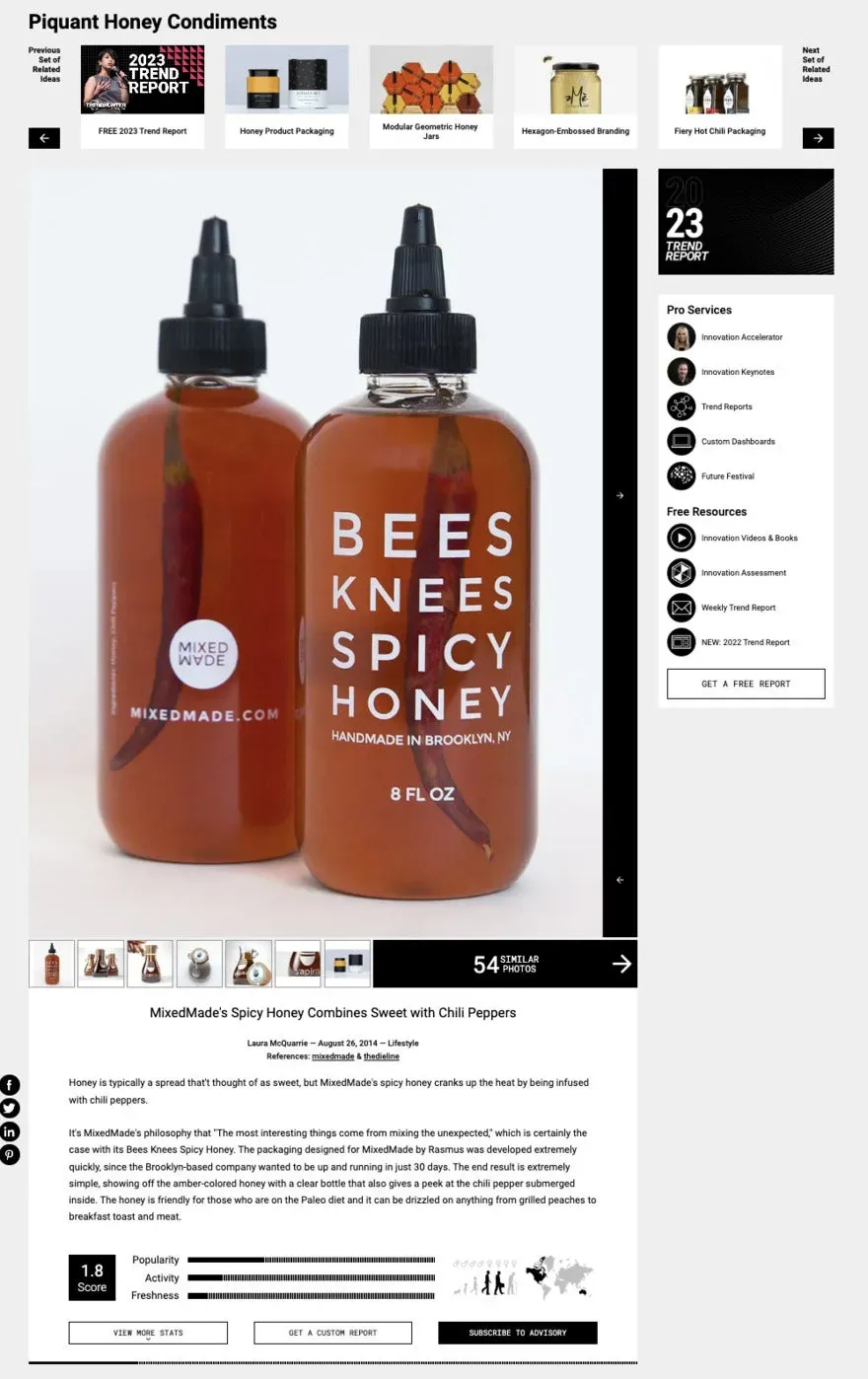
MixedMade’s spicy honey grabbed headlines at its launch.
To say the launch was a success would be the understatement of the year. There were so many orders that PayPal temporarily froze its account because the rate of sales was so unusual (don’t worry, PayPal unfroze it!). MixedMade made sure that it sourced as much as it could for fulfilling the glut in orders, and sent out personalized messages to the customers who would get their shipments a few days late.
But the success wasn’t just about selling spicy honey. Founders Morgan Newman and Casey Elsass and partner Ted Barbeau were determined to show that it’s never been so easy to run a successful ecommerce business. They made sure to blog every minute of the 30-day launch prep to give new ecommerce business owners a window into what’s involved, what works, and what doesn’t. What lessons can be learned by MixedMade’s success?
- Be bold – MixedMade’s ideas came from combining things they loved. Spicy honey wasn’t exactly a household condiment but it looked so striking that it got attention.
- Be agile – Things are going to go wrong, especially when you’re under pressure. Instead of panicking, think about what can be done, and while you’re getting those ducks in order, keep open communication with your customers.
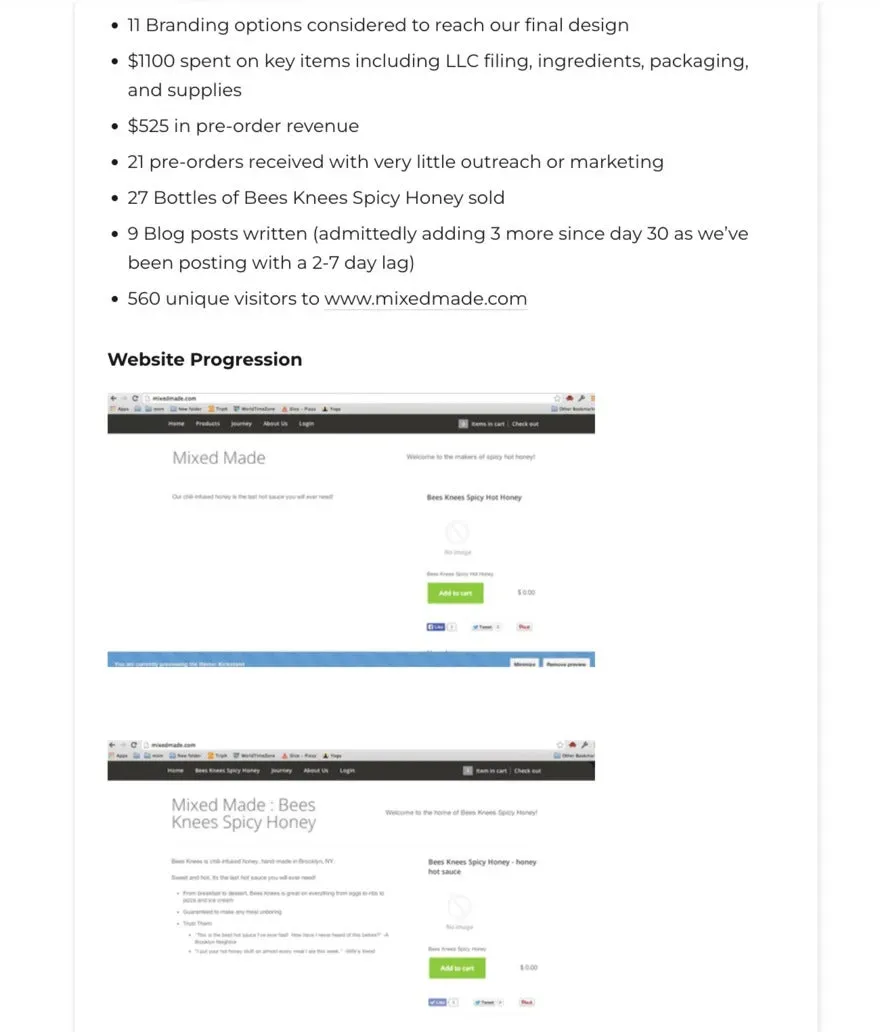
MixedMade’s transparent operations blog showed everything involved in starting an ecommerce business.
#5. Diamond Candles
Diamond Candles is one of our all-time favorite ecommerce success stories. When David Cayton wanted to propose to his girlfriend Brenda, he wasn’t sure how to make it special. He knew she loved candles, so he decided to hide the ring in the candle. It worked! And that’s where Diamond Candles came from.
Not only do its candles feature amazing scents, but each candle contains a ring inside. Sometimes it’s a costume jewelry ring. But sometimes, it’s the real deal. And to grow the customer base and keep them coming back, Diamond Candles hired ReSci to automate customer data and allow them to make predictions and provide individual customer experiences, like now giving customers the option to provide their ring size, so they always get a perfect fit.

Customer data helped Diamond Candles grant customer wants.
Diamond Candles has its own lessons for us:
- Have a story – Customers love an interesting origin story. It’s something that backs up your brand values and helps customers emotionally bond to the brand.
- Add something delightful or whimsical – it’s not just that customers can win diamond rings worth $100, $1,000, or $5,000. It’s how they find out – by using the product, building anticipation, and checking a mystery number. It’s a treasure hunt in a candle!

Customers get to enter a code buried in the candle to see if they’ve won big.
Top Tips for Ecommerce Success
Though each business has given us distinct lessons to learn, there are also five top tips for ecommerce success inspired by the brand examples above.
User Experience Is Top Priority
UX is one of the most important factors in your ecommerce business’ success. 90% of users won’t return to your site if they have a bad experience. Make sure that your customer enjoys interacting with your digital presence. The ROI on UX investment is 9,900%!
Experiment
In both your products and in how customers react to your products, don’t be afraid to experiment. Often a new ecommerce business has to try different things to figure out what works best for their target audience.
Commit to a Distinctive Voice – And Have Confidence People Will Get It
Anything that is memorable is different or disruptive in some way. There are already so many bland, boring ecommerce businesses, and to choose middle-of-the-road ecommerce means not only will you have tons of competition, but you’ll have no differentiation.
Have confidence in who you are, why you’re starting this business, and what’s important to you. You have to be distinctive for your audience of fellow distinctive people to find you.
Bring In Help When You Need To
Ecommerce is tricky. And though we might be into the hustle, there will be times when we need help from others. Whether that’s getting your friends and family to spread the word, or bringing in a copywriter to optimize your message to your audience, or even bringing in a data-collecting company to show you what your customers want, you don’t have to go it alone.
Add Value
Whether it’s tips and tricks, jokes, or even a fully transparent public log of your business operations to help new ecommerce business owners, you can’t beat adding value to customers’ lives. You don’t want to be known as a company that does nothing except push products onto customers. They’ll simply go somewhere else.
Advice from the Experts
Top Tip: A/B testing is a great place to start learning what works with your target audience.
Summary
No one said running an ecommerce business was easy. But it can be really fulfilling and a success, even if you experience a rocky start! Taking inspiration from those who have come out the other side through ecommerce success stories will give you what you need to keep going through those challenges.
Who knows? One day your ecommerce business success might inspire someone else. You’ve got this!
Now… anyone hungry for cornbread with spicy honey?